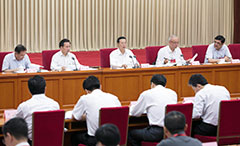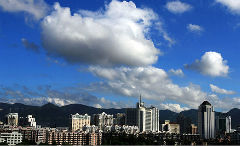New steps to tackle air pollution set for Beijing region
2017-08-23
China Daily
China will launch a regional campaign to help the Beijing-Tianjin-Hebei region and neighboring provinces control air pollution this autumn and winter, with more effort placed on regulating government officials and companies that pollute.
The Ministry of Environmental Protection has drawn up a series of plans for the regional campaign, which will start soon, Liu Youbin, a senior official from the ministry’s publicity department, said on Aug 22.
In addition to the general action plan for the campaign, officials will keep track of every issue reported and how it was resolved, Liu said.
Another six supportive documents were prepared with detailed stipulations on the key regions and industries, as well as to ensure the timely disclosure of problems to the public.
Those documents also list punishments that irresponsible government officials can expect during the campaign, he said, responding to reports that some disclosed pollution issues were not resolved.
“In the coming campaign, the ministry and involved governments will take efforts to keep the polluting companies from resuming production or will relocate them to other areas-and then fully implement the control measures,” he said.
The Beijing-Tianjin-Hebei region, prone to suffer through severe smog in the autumn and winter months, faces a large risk of air pollution returning in the coming months, the ministry said on Aug 20.
This past January and February, the concentration of PM2.5-hazardous fine particulate matter with diameter less than 2.5 microns-soared due to the severe air pollution in the region. This was caused by a confluence of several factors, including windless weather, active production, coal consumption for heating and vehicle exhaust, Liu said.
The ministry’s data showed that in the first seven months, the region’s PM2.5 average concentration increased by 11.3 percent year-on-year.
The average PM2.5 concentration in the region should by the end of this year be cut by 25 percent from the 2012 level.
Beijing needs to lower its PM2.5 level to 60 micrograms per cubic meter, as the central government required in 2013. The capital saw the average PM2.5 level fall to 52 in July, but in January it was as high as 116, a year-on-year increase of 70.6 percent.
To tackle the air pollution, the ministry has conducted a yearlong inspection of 28 major cities in the Beijing-Tianjin-Hebei region and the neighboring provinces of Shandong, Shanxi and Henan, which began in April.
The latest data from the ministry showed that through Aug 20, inspectors have checked 40,925 companies, of which 55 percent, or 22,620, were found with various pollution problems, such as discharging pollutants excessively or not installing emission-reduction equipment.
“Besides, these cities have found over 170,000 small and polluting companies, which should be shut down or improve their pollution reduction facilities,” said Bie Tao, head of the policy and laws department of the ministry, on Aug 22.


